According to official information, the trilateral naval manoeuvre Mosi II began on Friday, 17 February 2023. Until 27 February, Chinese, Russian and South African naval units will be holding a rendezvous on the east coast of South Africa in the sea area between Durban and the border with Mozambique. During the first deployment in November 2019, the three navies practised in the sea area around the Cape of Good Hope.
The practice name MOSI stands for smoke, vapour or mist in German. Mosi-oa-tunya - thundering smoke - is the common name for the Victoria Falls in the local language area.
The Chinese and Russian navies as partners
The veil over the details of the exercise has not yet been completely lifted by the responsible South African authorities. Nevertheless, the participation of three Chinese ships has been announced. The Russian frigate "Admiral Gorshkov" (type ship, hull number 454), which has been on a long-distance voyage with the Kaliningradneft-class tanker "Kama" since the end of last year, has been announced by name. According to Russian information, the frigate is to be equipped with the supersonic Zirkon missile. After a port call in Cape Town on the weekend of 12/13 February, it arrived in Durban on Saturday morning, 19 February. It is not known to what extent "Kama" is involved in the exercises. She arrived in Cape Town on 17 February and left the city on the Cape of Good Hope on 19 February.
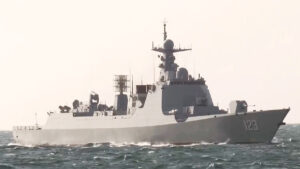
Chinese Lujang III-class destroyer "Huainan". Photo: chinamil.com
Fog lay over the Chinese exercise participants for a long time. The Luyang III-class guided missile destroyer "Huainan" (type 052D, hull number 123), the Jiangkai II frigate "Rizhao" (type 054A, hull number 598) and the task force provider "Kekexili Hu" (type 903A, hull number 968) make up Task Force 42 of the Chinese Navy. The three units left Quingdao on 21 September 2022, and after relieving Task Force 41 in the Gulf of Aden on 15 October, they operated along the East African coast, among other places. It therefore stands to reason that they will represent the Chinese delegation for Mosi II. Their participation was finally confirmed when the "Rizhao" arrived in Richards Bay on 19 February. According to the news platform Defence-Web, the "Huainan" and "Kekexili Hu" remained in the sea area.
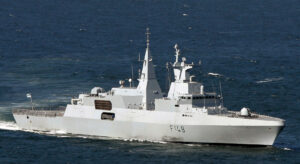
South African frigate "Mendi" of the Valour class (MEKO A200). Photo: Michael Nitz
The South African Navy will deploy the Valour-class frigate "Mendi" (MEKO A200 SAN, hull number F148), the now fifty-year-old survey vessel "Protea" (Hecla-class, A324) and "King Sekhukhune I" (Stan-Patrol Project BIRO, hull number P1571), a recently commissioned coastal patrol vessel (Multi Mission Inshore Patrol Vessel). The catamaran patrol vessel "Tekwane" (P1554) will also be utilised for the port call in Richards Bay. Earlier reports did not foresee the deployment of the frigate "Mendi" for the sea phase of the exercise. Should this be confirmed, it would be an insight into the shrinking operational capability of the South African fleet.
Exercise with zircon: sharp shot or dry run?
The exercise schedule provides for a harbour phase in Richards Bay, during which, in addition to the provisioning of the visiting ships and the conferences in preparation for the exercise, there will also be a series of naval activities (such as concerts, sporting events, demonstrations) that are customary during such harbour stays. The port call will be followed by exercises at sea from 25 February. The catalogue of exercises will include search and rescue, formation sailing and firing exercises.
In early February, the Russian agency TASS reported a test firing of a Zircon missile from the "Admiral Gorshkov" as part of the exercise off the South African coast. This was generally assumed to be a 'live fire' demonstration, but there has been no confirmation of this so far. The Russian wording 'Combat training launches of the hypersonic anti-ship missile "Zircon" for the first time as part of international exercises' is more likely to be interpreted as 'normal' weapon deployment training. The command and reporting chain, including functionalities such as opening the missile silos, is practised without live firing. Such training has already been reported several times on the website of the Russian Ministry of Defence during the voyage of the "Admiral Gorshkov". This means that a suspected Zircon shot could also vanish into thin air. The fact is that the "Admiral Gorshkov" is taking part in an international exercise for the first time.
Mosi II: the South African ambivalence
The anniversary of the Russian invasion of Ukraine falls within the manoeuvre period. This is causing irritation not only internationally, but also domestically. The opposition fears damage to relations with important Western partners such as the USA, the UK and the European Union. Both national and international critics see the exercise, in particular the participation of the "Admiral Gorshkov", as support from the South African government for Russia and its invasion of Ukraine in violation of international law.
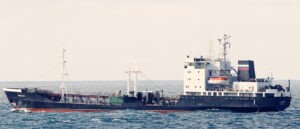
"Vyazma", sister ship of the tanker "Kama". Photo: Norwegian Navy
With the acceptance of the Russian exercise participant, which is also equipped with such a sensitive weapon system as Zircon, Moscow's favouritism becomes de facto. All the more so as no consideration is given to the anniversary of Moscow's attack on Ukraine. It already became tangible during the vote in the UN General Assembly on Resolution A/RES/ES-11/1 "Aggression against Ukraine" on 2 March 2022, when Pretoria (along with 34 other capital cities) abstained from voting. The government's predetermined neutrality is going up in smoke.
Other events also speak in favour of ambivalence. Pretoria allowed a mega yacht linked to the sanctioned Russian oligarch Alexey Mordashov to enter Cape Town. The sanctioned Russian cargo ship "Lady R" was allowed to call at Simons Town, the largest South African naval base and headquarters of the naval command.
Pretoria is caught between its orientation towards Europe and its ties to socialist-communist systems that grew during the anti-apartheid struggle. These ties arose from the ideological, financial and military support given to ANC cadres in Moscow, Beijing, Hanoi and Havana. Outwardly open to Washington, mistrust of the so-called West prevails within government circles. South Africa has repeatedly criticised the United States for its colonialist behaviour towards African countries and for trying to impose its political agenda on the whole world. In addition to the sympathies of political actors in Pretoria for Russia and China, the role of both as spoilsports vis-à-vis the USA could be another explanation for Pretoria's attitude.
Russia in Africa
South Africa's ruling elites are neglecting to recognise that Africa is nothing more than a playing field for influence in the midst of escalating global tensions. Russia is trying to expand its influence in Africa. While Moscow is acting without much scruple in the Sahel, the Kremlin can be more subtle in South Africa. Foreign Minister Sergei Lavrov's visit to South Africa in January 2023 went off without a hitch and by mutual agreement. Moscow is looking for further partners and bases in Africa - for its mercenary groups as well as for the armed forces. It has been able to expand its presence in unstable African regions and conflict areas, in addition to Mali in Libya and the Central African Republic. Its commitment to a base in Bur Sudan on the Red Sea seems unbroken. This week (13-18 February 2023), it was announced that the military council in Khartoum had approved the construction of a Russian naval base.
On the other hand, it has been observed that African waters in the Atlantic are increasingly being used for "dark" activities in the Russian oil trade - especially in adverse weather conditions. While the central North Atlantic was known as a hub for so-called STS (ship-to-ship) operations, these are now shifting to more southerly areas. During STS operations, ships load Russian oil onto other, less conspicuous tankers. This disguises the origin of the cargo. This allows Moscow to circumvent sanctions and the price caps imposed by the EU.
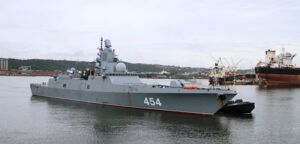
Russian Zircon frigate "Admiral Gorshkov" entering Durban. Photo: South African Defence Forces
The Kremlin's intensive diplomatic work - after all, the foreign minister has already travelled to Africa twice in 2023 - will be topped by the second Russia-Africa summit at the end of July in Saint Petersburg. Africa is thus becoming a 'living' example for the Kremlin that Russia is far removed from the kind of global isolation desired by the Europeans and the USA. This is emphasised by the military cooperation during the Mosi II exercise. Added to this is the importance of the black continent as a supplier of raw materials.
Ultimately, the voyage of the "Admiral Gorshkov" is nothing more than a propaganda campaign. The Kremlin is demonstrating that it is capable of global operations. And it knows how to impress and at the same time alarm with weaponry.
And China?
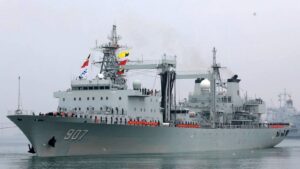
Chinese fleet supply ship "Luoma Hu" of the Fuchi class, sister ship of the "Kekexili Hu". Photo: chinamil.com
China began to cultivate the field in Africa earlier. Africa is important for Beijing to cover its resources, which are vital for industrial and economic progress. The military also plays a role in this. The pattern of action is familiar: Entering into semi-military alliances, building or utilising port facilities for civil-military purposes, stationing troop contingents, participating in missions for peace-building military measures or as part of disaster prevention ('military operations other than war') and supplying weapons to the region. China opened its first African base in Djibouti in 2017. At the end of 2022, its attempts to do so in Equatorial Guinea and Mauritius became known.
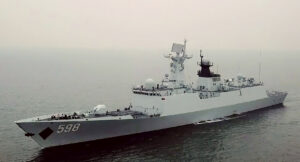
Chinese Jiangkai II-class frigate "Rizhao". Photo: MoD China
Under these circumstances, South Africa is a business opportunity for China. The fact that the Chinese units presumably participating in Mosi II as a task force represent a permanent presence in the Indian Ocean confirms the approach described above.
Moscow-Beijing
Finally, Russian-Chinese cooperation must also be taken into account in connection with the naval exercise on South Africa's coast. MOSI is part of the observation of a growing entente between Moscow and Beijing. The collective behaviour goes beyond the joint zone of influence in the Western Pacific. In recent years, naval forces of the Russian Federation and the People's Liberation Army have deployed together in the Indian Ocean. In December 2019, immediately after MOSI I, there was a trilateral naval exercise with Iranian naval forces.
Most recently, in December 2022, units of the Chinese and Russian naval forces practised in the East China Sea.
In the middle of Mosi II: South African Armed Forces Day
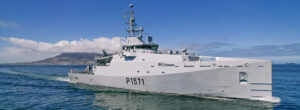
Multi Mission Inshore Patrol Vessel BIRO-Project "King Sekhukhune I". Photo: Damen Shipyard Cape Town
The South African Armed Forces Day celebrations also fall within the exercise period. Every year on 21 February, as Armed Forces Day, the nation remembers the sinking of the troopship "SS Mendi" in the English Channel on 21 February 1917. Over 600 soldiers lost their lives. The day of remembrance has developed into a week-long PR event organised by the South African armed forces. With over 8,000 soldiers deployed, the largest Armed Forces Day to date is to be celebrated in 2023, according to an announcement by the South African General Staff. President Cyril Ramaphosa will attend the celebrations in Richards Bay. However, a period of bad weather with heavy rainfall casts a shadow over Armed Forces Day. Seven of South Africa's nine provinces, including the host province of KwaZulu-Natal, have declared a state of disaster.
A national state of emergency had previously been declared due to constant nationwide power cuts. Both states of emergency also overshadow the activities surrounding Mosi II.
Conclusion
From a Western perspective, South Africa is doing itself a disservice with Mosi II. On the one hand, the exercise gives South Africa's ruling elites an opportunity to demonstrate their ties with former comrades in arms. On the other hand, the operational value of the manoeuvre is questionable. The South African journalist Helmoed Heitman described MOSI I as a 'superficial passex'. This refers to exercises between naval forces at a subliminal level, which primarily serve to establish contact and maintain communication. Even the exercise system of a port programme that is clearly overweight compared to the sea phase arouses scepticism. Added to this is the local separation of the units. On the other hand, the South African Navy must be allowed to practise with other navies. Not many navies stray to the Cape of Good Hope.
In view of the national emergency situation in South Africa, the public is critical of the usefulness of the manoeuvre. The financial expenditure would be better invested in supporting the population.
It will be interesting to see how zircon can be used.
Video: Arrival of the "Admiral Gorshkov" in Cape Town:









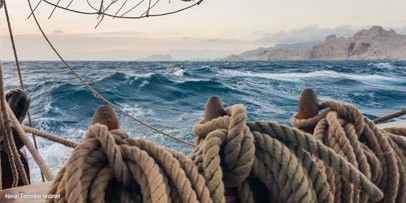

Moin,
In the meantime, it has been reported that there will be no FK firing with the hypersonic missile "Tsirkon" by the Russian frigate "Admiral flota Sovetskogo Soyuza Gorshkov" ("Адмирал флота Советского Союза Горшков") as part of the three-sided exercise "Mosi-2023". During the active training phase from 25 - 27 February, joint artillery firing will be carried out, among other things.
This was stated by the superior on board, the commander of the 43rd missile ship division of the Northern Fleet, Captain 1st Rank Oleg Gladkij (Олег Гладкий) during a briefing today, Wednesday.
You can read about this here: https://tass.ru/armiya-i-opk/17121311
Great. Thank you, Mr Engel. Sorry for the late feedback.
PS. Which means I wasn't entirely wrong in my assessment that a lot of smoke is being made about nothing.
Now we can look forward to seeing what will happen during the Mediterranean passage of the "Admiral Gorshkov"!